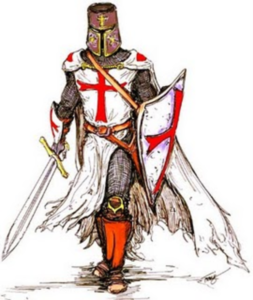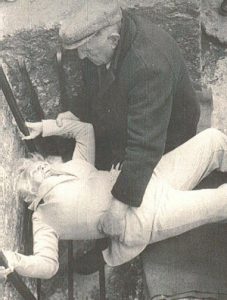christianity
 The word knight always makes me think of medieval men in full armor fighting with shields and swords, and maybe that isn’t so far off with the Knights Templar. One thing I didn’t connect to the knights, was Christianity, but maybe I should have. The medieval knights are a little outside my wheelhouse, but I have had an interest in them for a while now, and the Knights Templar are at the top of my list. So, I decided to have a look at exactly what they are, beginning with the Knights Templar.
The word knight always makes me think of medieval men in full armor fighting with shields and swords, and maybe that isn’t so far off with the Knights Templar. One thing I didn’t connect to the knights, was Christianity, but maybe I should have. The medieval knights are a little outside my wheelhouse, but I have had an interest in them for a while now, and the Knights Templar are at the top of my list. So, I decided to have a look at exactly what they are, beginning with the Knights Templar.
After Christian armies captured Jerusalem from Muslim control in 1099 during the Crusades, groups of pilgrims from across Western Europe started visiting the Holy Land. As they traveled, many of them were robbed and killed crossing through Muslim-controlled territories during their journey. A French knight named Hugues de Payens created a military order along with eight relatives and acquaintances, calling it the Poor Fellow-Soldiers of Christ and the Temple of Solomon. Later known simply as the Knights Templar (Knights of the Temple), it was founded in 1118 in Jerusalem, and was a large organization of devout Christians who carried out an important mission: to protect European travelers visiting sites in the Holy Land. The first headquarters of the Knights Templar was located on the site of the Temple of Solomon, and it was to this temple that the organization was dedicated and where it got its name.
Initially, the Knights Templar faced criticism from some religious leaders. There are always those who think the church and any kind of government or military group should not mix, but in 1129, the group received the formal endorsement of the Catholic Church and support from Bernard of Clairvaux, a prominent French abbot. Bernard authored “In Praise of the New Knighthood,” a text that supported the Knights Templar and bolstered their growth. In 1139, Pope Innocent II issued a Papal Bull that allowed the Knights Templar special rights. Among them, the Templars were exempt from paying taxes, permitted to build their own oratories and were held to no one’s authority except the Pope’s.
The Knights Templar quickly set up a network of banks and gained enormous financial influence, with an ability to quickly fund their work. Their banking system allowed religious pilgrims to deposit assets in their home countries and withdraw funds in the Holy Land. The order became known for its austere code of conduct (which included no pointy shoes and no kissing their mothers, rules outlined in “The Rule of the Templars”) and signature style of dress, which featured a white habit emblazoned with a simple red cross. Members swore an oath of poverty, chastity and obedience. They weren’t allowed to drink, gamble or swear. Prayer was essential to their daily life, and the Templars expressed particular adoration for the Virgin Mary.
New chapters of the Knights Templar were established throughout Western Europe as the group grew in size and status. At the height of their influence, the Templars had a sizable fleet of ships, and they owned the Mediterranean island of Cyprus. They served as a primary bank and lending institution to European monarchs and nobles. Though its original purpose was to protect Christiam pilgrims from danger, the Knights Templar later expanded its duties. They became defenders of the Crusader states in the Holy Land and were known as brave, highly skilled warriors. The group developed a reputation as fierce fighters during the Crusades. They were driven by religious zeal and forbidden from retreating unless significantly outnumbered, and I doubt if they would even then. The Templars built numerous castles. They fought, and often won, battles against Islamic armies. Their fearless style of fighting became a model for other military orders. They were quite the group.
 Sometimes, the best laid plans fall just a little bit short of the dream come true. The big plan for our lives, becomes the backup plan. As a trained dental hygienist, my grand niece, Christina Masterson will always have that profession to fall back on, but the doing hasn’t lived up to her expectations. So, it’s back to the drawing board for Miss Christina. With a strong family background in Christianity, she has decided to go to Bible college. I don’t know exactly what her future in this area would look like, but Bible college doesn’t always mean being a preacher. It could be that she will decide to preach, but she could also go into youth ministry, music ministry, or even author Christian books. Christina hasn’t said specifically, what her future looks like in her own head, but she is excited at the prospect of moving forward with this new master plan.
Sometimes, the best laid plans fall just a little bit short of the dream come true. The big plan for our lives, becomes the backup plan. As a trained dental hygienist, my grand niece, Christina Masterson will always have that profession to fall back on, but the doing hasn’t lived up to her expectations. So, it’s back to the drawing board for Miss Christina. With a strong family background in Christianity, she has decided to go to Bible college. I don’t know exactly what her future in this area would look like, but Bible college doesn’t always mean being a preacher. It could be that she will decide to preach, but she could also go into youth ministry, music ministry, or even author Christian books. Christina hasn’t said specifically, what her future looks like in her own head, but she is excited at the prospect of moving forward with this new master plan.
It would be impossible to say for sure where the future will take Christina, but she is excited about it, and that is what matters. Even if she doesn’t go into a field that uses her Bible college lessons, studying the Bible is never a bad idea. In fact, it is something we should all take the time to do…at least on our own, because no matter what future choices we make for ourselves, our lives will always go better if we put God in charge of our plans.
Christina is a sweet girl, the oldest of my nephew Rob Masterson’s four kids. She is also the oldest of her 
 mother, Angela Beck’s four kids. The rest of the kids are a bit younger, and still in public school. The younger ones may not realize it, but they are probably looking to Christina to show them the way to go. It’s probably a lot to put on a young woman’s shoulders, but she can do it…if she doesn’t sell herself short. Being a role model is not an impossible task. All that is needed is to realize that some little people are looking to you to show them how to be great, and I think she’s got this. Today is Christina’s birthday. Happy birthday Christina!! Have a great day!! We love you!!
mother, Angela Beck’s four kids. The rest of the kids are a bit younger, and still in public school. The younger ones may not realize it, but they are probably looking to Christina to show them the way to go. It’s probably a lot to put on a young woman’s shoulders, but she can do it…if she doesn’t sell herself short. Being a role model is not an impossible task. All that is needed is to realize that some little people are looking to you to show them how to be great, and I think she’s got this. Today is Christina’s birthday. Happy birthday Christina!! Have a great day!! We love you!!
 Like many avid genealogists, I find myself looking at my roots often. As Saint Patrick’s Day rolls around, I find myself contemplating my Irish roots. I’m sure there are more than I can begin to count, but I specifically know of the Shaw family. These are my grandmother, Harriett Byer’s ancestors. The thing that I find to be sad is that the records are not as extensive as I wish they were. My DNA connects me to this family, but the 1600s is as far as I have been able to trace. I suppose that many people would think that the 1600s is a long way back, but it is barely to the point of their immigration from Ireland to the United States. Even in America, the records aren’t well kept. I find it quite sad that some families are so meticulous in their record keeping, while others just weren’t.
Like many avid genealogists, I find myself looking at my roots often. As Saint Patrick’s Day rolls around, I find myself contemplating my Irish roots. I’m sure there are more than I can begin to count, but I specifically know of the Shaw family. These are my grandmother, Harriett Byer’s ancestors. The thing that I find to be sad is that the records are not as extensive as I wish they were. My DNA connects me to this family, but the 1600s is as far as I have been able to trace. I suppose that many people would think that the 1600s is a long way back, but it is barely to the point of their immigration from Ireland to the United States. Even in America, the records aren’t well kept. I find it quite sad that some families are so meticulous in their record keeping, while others just weren’t.
My Grandma Byer and her siblings were proud of their Irish roots. In their later years, they took a trip to Ireland to search for family information, graves, and living family members. I’m not sure if they found much  information, but without computers, information was harder to find then. It’s not that computers didn’t exist, but rather the simple fact that none of them knew how to use one. Nevertheless, they had a wonderful trip. They explored castles, town and villages, and they saw the amazing green fields that are synonymous of Ireland. They also did something that I have found interesting, when the had the opportunity to kiss the Blarney Stone. For those who don’t know about the Blarney Stone, “The Blarney Stone (Irish: Cloch na Blarnan) is a block of Carboniferous limestone built into the battlements of Blarney Castle, Blarney, about 8 kilometers (5 miles) from Cork, Ireland. According to legend, kissing the stone endows the kisser with the gift of the gab (great eloquence or skill at flattery).” It’s really just a goofy tradition, but I suppose it is a fun idea, and one they decided was worth testing.
information, but without computers, information was harder to find then. It’s not that computers didn’t exist, but rather the simple fact that none of them knew how to use one. Nevertheless, they had a wonderful trip. They explored castles, town and villages, and they saw the amazing green fields that are synonymous of Ireland. They also did something that I have found interesting, when the had the opportunity to kiss the Blarney Stone. For those who don’t know about the Blarney Stone, “The Blarney Stone (Irish: Cloch na Blarnan) is a block of Carboniferous limestone built into the battlements of Blarney Castle, Blarney, about 8 kilometers (5 miles) from Cork, Ireland. According to legend, kissing the stone endows the kisser with the gift of the gab (great eloquence or skill at flattery).” It’s really just a goofy tradition, but I suppose it is a fun idea, and one they decided was worth testing.
The big Saint Patrick’s Day parties are far more an American tradition than it is as Irish one. In fact, people might be surprised at the real background of the day. Saint Patrick’s Day was made an official Christian feast day in the early 17th century and is observed by the Catholic Church, the Anglican Communion (especially the Church of Ireland), the Eastern Orthodox Church, and the Lutheran Church. In reality, It is a day that  commemorates Saint Patrick and the arrival of Christianity in Ireland. It also celebrates the heritage and culture of the Irish in general. Celebrations generally involve public parades and festivals, cèilidhs (a social event at which there is Scottish or Irish folk music and singing, traditional dancing, and storytelling), and the wearing of green attire or shamrocks. Some Catholic Christians also attend church services and historically in Ireland the Lenten restrictions on eating and drinking alcohol were lifted for the day, which is likely where the holiday’s tradition of alcohol consumption came from. So, whether you celebrate in the tradition of America or the tradition of Ireland, Happy Saint Patrick’s Day to one and all.
commemorates Saint Patrick and the arrival of Christianity in Ireland. It also celebrates the heritage and culture of the Irish in general. Celebrations generally involve public parades and festivals, cèilidhs (a social event at which there is Scottish or Irish folk music and singing, traditional dancing, and storytelling), and the wearing of green attire or shamrocks. Some Catholic Christians also attend church services and historically in Ireland the Lenten restrictions on eating and drinking alcohol were lifted for the day, which is likely where the holiday’s tradition of alcohol consumption came from. So, whether you celebrate in the tradition of America or the tradition of Ireland, Happy Saint Patrick’s Day to one and all.

